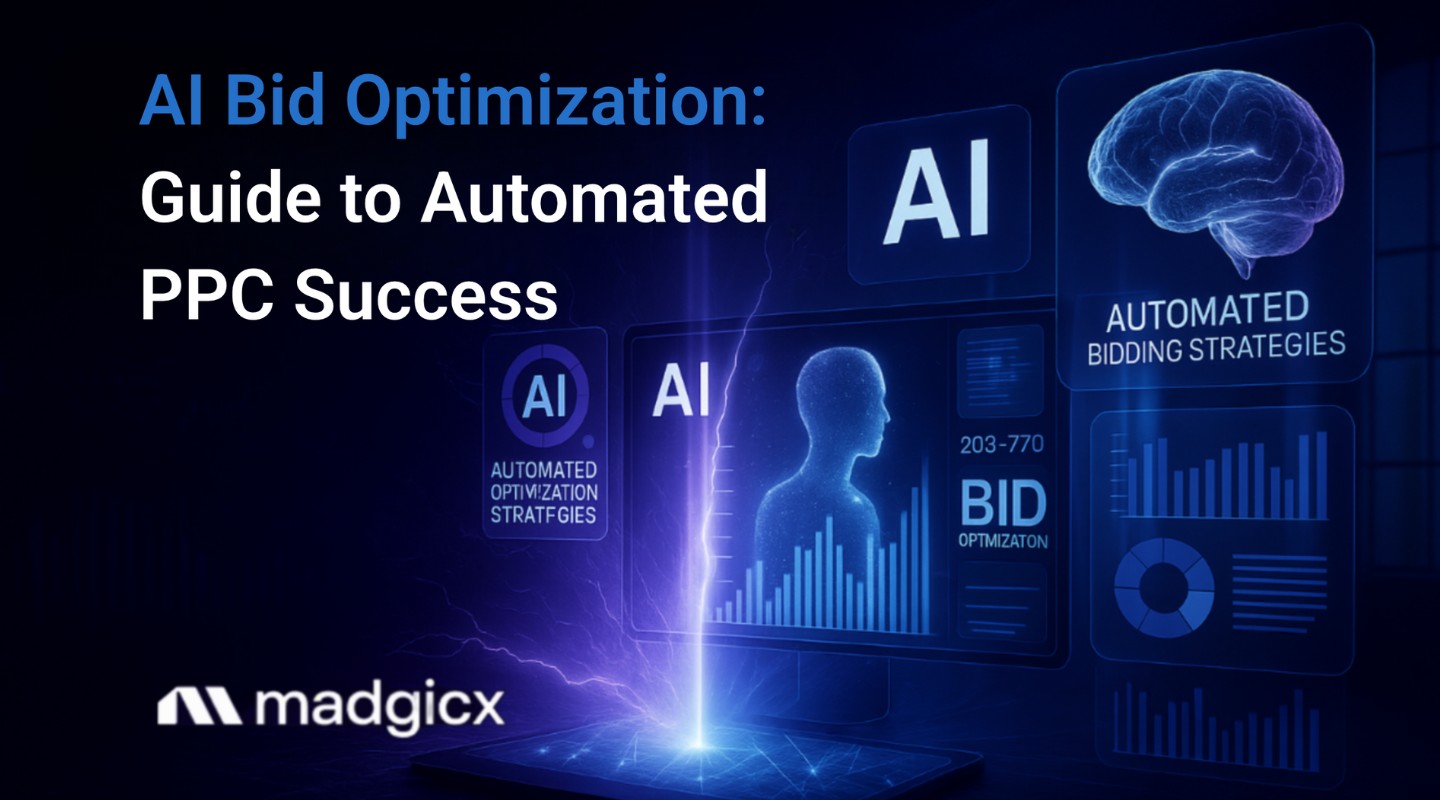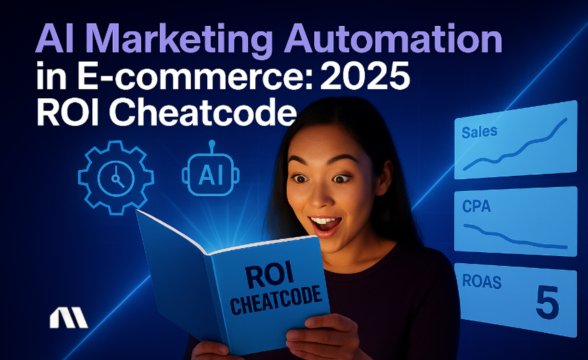Learn how AI bid optimization works to automate PPC success. Complete guide with setup, troubleshooting, and ROI benchmarks for maximum advertising performance.
You're staring at your PPC dashboard at 11 PM, manually adjusting bids for the third time today. Sound familiar?
While you're burning the midnight oil tweaking campaigns, your competitors are sleeping soundly—because they've handed the reins over to AI bid optimization.
Here's the reality: 80% of Google Ads accounts now use Smart Bidding. But here's what most guides won't tell you—setting up AI bid optimization is just the beginning.
The real magic happens in the troubleshooting, fine-tuning, and advanced strategies that separate the pros from the amateurs.
AI bid optimization uses machine learning algorithms to automate and refine ad bidding in real time, enabling advertisers to maximize ROI and minimize wasted spend through data-driven decisions. This comprehensive guide covers everything from the technical foundation to advanced troubleshooting techniques that most resources skip entirely.
What You'll Learn
By the end of this guide, you'll understand exactly how AI bid optimization algorithms work behind the scenes, master the step-by-step setup process for major platforms, and—most importantly—know how to troubleshoot when things go sideways.
Plus, we'll share performance benchmarks and ROI calculations from real campaigns that'll help you set realistic expectations.
What Is AI Bid Optimization? (The Technical Foundation)
Let's cut through the marketing fluff and get technical. AI bid optimization is a machine learning system that analyzes thousands of data points in real time to determine the optimal bid for each ad auction.
Unlike rule-based bidding (if this, then that), AI systems learn from patterns and continuously adapt their strategies.
Here's how it actually works: The algorithm processes conversion history, audience signals, device types, time of day, geographic location, and dozens of other contextual factors. It then predicts the likelihood of conversion for each potential impression and calculates the maximum bid that aligns with your target metrics.
The key difference between real-time and batch optimization? Real-time systems make bidding decisions at the moment of each auction (we're talking milliseconds), while batch systems analyze performance data and adjust bids periodically. Most modern platforms use real-time optimization because auction dynamics change constantly.
Think of it like having a data scientist who never sleeps, never gets tired, and can process information faster than you can blink. That's essentially what you're getting with AI bid optimization—except this data scientist has access to your entire account history and can make split-second decisions based on patterns you'd never spot manually.
How AI Bid Optimization Works Under the Hood
Now, let's peek behind the curtain. The machine learning model training process is where the magic begins. When you first enable AI bidding, the algorithm enters what's called a "learning phase." During this period (typically 2 weeks), it's collecting data about your audience, analyzing conversion patterns, and building predictive models.
Here's what the AI is actually learning:
- Conversion History: Which audiences, keywords, and placements drive results
- Audience Signals: Demographics, interests, and behavioral patterns of converters
- Contextual Factors: Time of day, device type, geographic performance variations
- Competitive Landscape: How aggressive other advertisers are in your auctions
The auction-time decision making happens in milliseconds. When an impression opportunity arises, the AI evaluates the conversion probability, considers your target metrics (CPA, ROAS, etc.), and submits a bid calculated to maximize your objectives while staying competitive.
Pro Tip: The first 2 weeks are absolutely crucial for algorithm training. Resist the urge to make major changes during this period—you'll essentially reset the learning process and delay optimal performance.
The feedback loop is continuous. Every conversion (or lack thereof) feeds back into the model, refining its predictions. This is why AI bid optimization typically improves over time, unlike manual bidding strategies that remain static until you intervene.
Platform-Specific Implementation Guide
Google Ads Smart Bidding
Google's Smart Bidding offers several strategies, but the two most relevant for performance marketers are Target CPA and Target ROAS. Here's when to use each:
Target CPA works best when you have a specific cost-per-acquisition goal and want to maximize conversions within that constraint. Set your target about 10-20% higher than your current CPA to give the algorithm room to learn.
Target ROAS is ideal when you're focused on revenue efficiency. Start with a target that's 10-15% lower than your current ROAS, then gradually increase as performance stabilizes.
Setup walkthrough:
- Navigate to your campaign settings
- Select "Bidding" and choose your Smart Bidding strategy
- Set your target metric (CPA or ROAS)
- Enable "Enhanced CPC" as a fallback during learning phase
- Monitor performance in the "Bid Strategies" report
The performance monitoring dashboard shows learning status, performance trends, and auction insights. Pay special attention to the "Learning" status—this indicates whether the algorithm has sufficient data to optimize effectively.
Meta Automated Bidding
Meta's approach centers around Advantage Campaign Budget, which automatically distributes budget across ad sets based on performance potential. The platform's AI considers factors like audience overlap, creative performance, and placement efficiency.
For bid strategy selection, "Lowest Cost" works well for awareness campaigns, while "Cost Cap" gives you more control over efficiency metrics. Post-iOS 14.5, Meta's AI relies heavily on Conversions API data, making proper server-side tracking essential.
Madgicx AI Marketer
Here's where things get interesting. While platform-native solutions optimize within their own ecosystems, Madgicx's AI Marketer provides cross-platform optimization insights that consider performance holistically.
The system analyzes your Google Ads, Meta campaigns, and website data simultaneously to identify scaling opportunities and budget reallocation recommendations.
The advanced attribution modeling helps solve the fragmented data problem that plagues most performance marketers. Instead of managing separate optimization systems, you get unified insights and automated recommendations across all your advertising channels.
The AI-powered optimization recommendations work continuously, meaning you're getting insights beyond just business hours. The AI monitors performance and provides micro-adjustment recommendations that compound into significant improvements over time.
Start with the 7-day free trial, and see for yourself.
Performance Benchmarks and ROI Data
Let's talk numbers. According to The Digital Cauldron, advertisers using AI bid optimization saw an average 37% drop in CPA within 90 days of implementation. That's not just marginal improvement—that's significant efficiency gains.
The time savings are equally impressive. With Adalysis, Click Pilot reports saving at least 40 hours of work per month on managing PPC campaigns. Think about that: nearly 5 full workdays returned to your schedule every month.
Advanced Troubleshooting Guide
When AI bid optimization underperforms, don't panic—troubleshoot systematically. Here's your diagnostic checklist:
Learning Phase Issues
- Verify sufficient conversion volume (minimum 15 conversions per week)
- Check conversion tracking accuracy
- Ensure stable campaign structure (avoid frequent changes)
- Confirm budget isn't constraining delivery
Signal Quality Diagnostics
- Review conversion delay patterns (long delays confuse algorithms)
- Audit conversion definitions (are you tracking the right actions?)
- Assess audience quality (broad audiences often perform better initially)
- Evaluate creative performance (poor creative limits AI effectiveness)
Manual Override Strategies
Sometimes you need to step in. Use manual bid adjustments for:
- High-value keywords during promotional periods
- New product launches requiring aggressive positioning
- Seasonal fluctuations the AI hasn't learned yet
- Competitive situations requiring immediate response
Performance Threshold Setting
Establish clear parameters for when to intervene:
- CPA increases >30% for 7+ consecutive days
- ROAS drops >20% with stable conversion volume
- Learning phase extends beyond 4 weeks
- Impression share drops significantly without budget constraints
Pro Tip: Red flags that indicate algorithm confusion include erratic bidding patterns, sudden performance drops after stable periods, and learning phases that never complete. When you see these signals, review your conversion tracking and campaign structure immediately.
Best Practices for Maximum ROI
Optimal campaign structure for AI requires balance. Too granular, and you fragment learning data. Too broad, and you lose targeting precision.
The sweet spot? Start with broader targeting and let the AI identify high-performing segments, then create dedicated campaigns for your best performers.
Conversion tracking requirements are non-negotiable. AI systems need clean, accurate data to optimize effectively. Implement server-side tracking, use machine learning marketing principles for data quality, and regularly audit your conversion definitions.
Budget allocation strategies should account for learning phases. A practical mix is to allocate about 40–60% of your budget to proven top-performing campaigns, 20–30% to experiments, and 10–20% to niche or emerging platforms. This balance ensures you’re reinforcing what works while leaving room for testing new strategies and maintaining flexibility.
Monitoring schedules don't need to be obsessive. Check performance weekly during stable periods, daily during learning phases, and immediately after any significant changes. The goal is oversight, not micromanagement.
Pro Tip: Maintain control while letting AI optimize by setting appropriate guardrails. Use bid limits, audience exclusions, and performance thresholds to keep campaigns within acceptable parameters while giving algorithms room to work.
Future of AI Bid Optimization
The 2025 trends point toward even more sophisticated optimization. Privacy-first strategies are becoming essential as third-party cookies disappear and attribution becomes more challenging. Platforms are investing heavily in first-party data solutions and contextual targeting capabilities.
Cross-platform attribution improvements are accelerating. Tools like AI tools for social media are evolving to provide unified measurement across channels, solving the fragmented attribution puzzle that's plagued performance marketers for years.
The emergence of agentic AI in advertising represents the next evolution. These systems won't just optimize bids—they'll make strategic decisions about budget allocation, audience expansion, and creative testing autonomously.
Frequently Asked Questions
How long does it take for AI bidding to show results?
Most platforms require 2 weeks for initial learning, with optimal performance typically achieved within 4-6 weeks. However, you should see directional improvements within the first week if your setup is correct.
Can I override AI decisions when needed?
Absolutely. All platforms allow manual bid adjustments, though frequent overrides can disrupt learning. Use manual controls strategically for special situations rather than regular optimization.
Is AI bidding suitable for small budgets?
AI bid optimization works best with sufficient data volume. For budgets under $1,000/month, consider starting with enhanced manual bidding and transitioning to full automation as volume increases.
How does AI bidding work post-iOS 14.5?
Modern AI systems adapt to reduced signal availability by relying more heavily on first-party data, contextual signals, and modeled conversions. Server-side tracking becomes crucial for optimal performance.
What's the difference between platform AI and third-party tools?
Platform-native AI optimizes within that specific ecosystem, while third-party tools like Madgicx provide cross-platform optimization and advanced attribution modeling that single-platform solutions can't match.
Start Optimizing Your Bids with AI Today
AI bid optimization isn't just a nice-to-have anymore—it's table stakes for competitive performance marketing. The data shows potential for 37% CPA reduction, 40 hours saved monthly, and improved ROAS across virtually every implementation we've analyzed.
The key is proper setup, patience during learning phases, and systematic monitoring rather than constant tinkering.
Your next step? Start with one campaign using automated bidding, monitor performance for 2-3 weeks, then scale successful strategies across your account. Remember, the goal isn't to eliminate human oversight—it's to amplify your strategic thinking with AI-powered execution.
Madgicx's AI Marketer takes this concept further by helping coordinate optimization across multiple platforms simultaneously, giving you insights that single-platform solutions simply can't match. While others optimize individual platforms, Madgicx helps coordinate a unified, intelligent advertising strategy that maximizes every dollar of your budget.
Stop spending hours on manual Meta bid adjustments. Madgicx's AI Marketer helps optimize your Meta ads bids around the clock, using advanced machine learning to improve your ROAS while you focus on strategy.
Digital copywriter with a passion for sculpting words that resonate in a digital age.







.avif)





.jpg)
.jpg)
